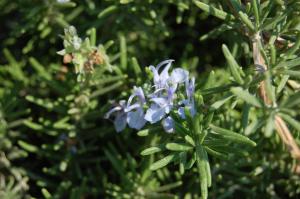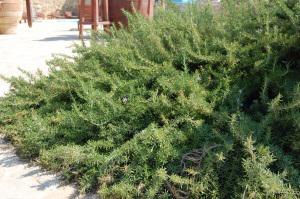
Rosmarinus officinalis 'Prostratus' flower (02/09/2011, Koufonisi, Greece)
Position: Sunny position
Flowering period: Summer
Soil: Well Drained
Eventual Height: 0.5m
Eventual Spread: 1.5m
Hardiness: USDA Zones 7a-10b
Family: Lamiaceae
Rosmarinus officinalis is an evergreen woody, perennial herb with fragrant, needle like leaves. It’s evergreen leaves are 2-4cm long and 2-5mm broad, green above and white below with dense short wooly hair. The hermaphrodite flowers are blue flowers. These are followed by a fruit which consists of a dry nut which is comprised of four sections. The Prostratus Group are compact evergreen shrubs of prostrate habit, with linear, aromatic leaves.
R. officinalis ‘Prostratus’, commonly known as Trailing rosemary, is native to the Mediterranean region in southern Europe. In Italy it is mainly used as a potted plant and is widely used in landscape schemes. Rosemary is associated with with the Greek goddess Aphrodite and the Virgin Mary.
The name Rosmarinus is derived from the Latin ros meaning ‘dew’ and marinus meaning ‘sea’ referring to the plants ability to accumulate all the water it requires from the humidity from the sea. Officinalis is derived from the Latin meaning ‘of the shop’ referring to the historic sale of this herb. ‘Prostratus’ is derived from the Latin meaning for prostrate or to lay low.

Rosmarinus officinalis 'Prostratus' (02/09/2011, Koufonisi, Greece)
The landscape architect may find this shrub as an effective ground cover plant, suitable for use in arid areas as it can survive drought conditions once established.
This plant prefers sandy to loamy soils and will tolerate any soil pH. This plant will not tolerate water-logging.
Ecologically this evergreen shrub attracts honey bees, bumble bees and butterflies
Maintenance: Requires little to no maintenance. This plant may be pruned any time of year.

